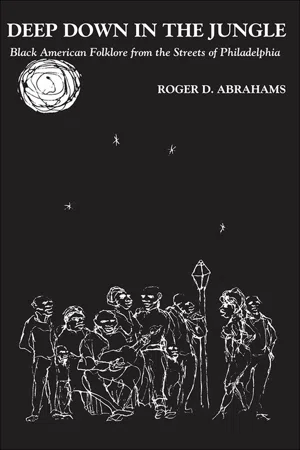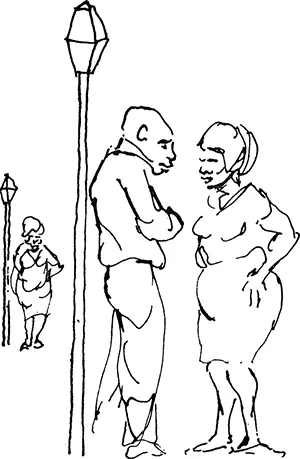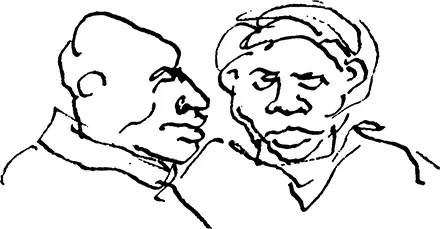INTRODUCTION
STYLE AND PERFORMANCE
IN THE FIRST SECTION OF THIS WORK THE SOCIAL MILIEU OF A GROUP OF young Negro story-tellers was examined along with certain elements of the narratives in order to place these pieces and their performers in as full a light as possible and to explore the process by which their traditional literature interacts with other aspects of their lives. Specifically, the object there was to show how the family life of the group created a situation of emotional deprivation which had great effect on the traditional modes of expression, especially in the oral literature. There, some aspects of the texts were outlined or underlined, not so much to render the stories themselves comprehensible but rather to show more fully the relationship between text and teller.
This section will be devoted to a presentation of the stories themselves, and all discussion therefore will be centering upon them. All of the narratives collected in Camingerly, except for a few reserved for a discussion in an appendix, will be given here in as faithful a transcription as one who is untrained in linguistics can offer. Through discursive headnotes to individual pieces an attempt will be made to trace their history and to reveal any meanings which might otherwise be lost. Any words or expressions of esoteric meaning will be marked with an asterisk and discussed briefly in the glossary. As G. Legman has been so abundantly helpful in matters of annotation, I have elected to present any of his comments, where relevant, in his own words. The reader must therefore continually bear in mind that Legman’s remarks are given in something of an alien context as they were originally conveyed in personal letters. They will simply be prefaced by his name and a dash.
The stories will be divided into two categories, the toast and the joke. This division is dictated by stylistic generic considerations, and for purposes of clarification as well as an attempt to tie in matters from the first section, the stylistic patterns and conventions will be described in the introductions to each genre.
The problem of style in literature, oral or written, is one which has been especially clouded by romantic and impressionistic attempts at definition. Ultimately style is not definable as the form of expression which a writer will fall into when he finds his “true voice.” It is also not something which is revealed in its fullest sense through some adjectival or metaphorical approach. It is rather the recurrence of linguistic entities which provide an objectively describable pattern in terms of sounds, words, rhythms, syntactical constructions, and even perhaps units of meanings. “Style is nothing if it is not an overtly conscious striving for design on the part of the artist.”1 It will be the purpose of the introductions of the genres to attempt to point out the stylistic elements which recur most often in them, and if possible to indicate those which always occur, thus defining the genre.
Any consideration of style, however, creates theoretical problems. Because style has been seen as the dressing of the artist, the literary analyst has been driven to stylistic perceptions in regard to the production of the individual artist. To do so is to emphasize what the linguist would call the ideolect. If one is to unite a writer’s method with his themes and central vision, his “world,” one must, I suppose, do just such an analysis. However to do so is to ignore, or at least take for granted, the existence of a certain number of patterns which a specific language and culture exhibits. These patterns are as truly stylistic as any individual adaptive configurations of them are. For the folklorist at least, these cultural-linguistic patterns are more important than those refinements utilized by the artist, because these embody the forms accepted by the past and utilized in the present; they are the structures of tradition. It is by means of these patterns that the simplest levels of communication are preserved and the forms of the past transmitted to the present.
This point needs clarification. Linguists are fond of making a distinction between casual and noncasual utterances,2 between “common usage and uses of language for more restricted purposes and often enough, perhaps characteristically, more elevated purposes.”3 The distinction is one which echoes the linguists’ preoccupation with common usage (at least as the point of departure for their descriptive grammars). Language has structure and it is best describable in utterances which are part of general discourse. But linguists have long realized that there are certain preset exceptions of usage in every language, where what appear to be the rules for conversational languages are abrogated. These they call “non-casual” utterances, and they look to them for the established and accepted deviations in the language structure. Thus, in a sense, every language has two structures closely related to each other, one called “casual” and the other “noncasual.”
The usual method for defining the noncasual aspects of a language are through syntactic constructions and certain elements of diction which are permissible under the special circumstances in which such utterances are invoked. Much more reliable, however, would be to see noncasual language as that exhibiting style, for these diction and syntactical changes are just two areas of change which are used in order to create the kind of recurrent patterns which denominate noncasual utterance. There are linguistic elements found in both casual and noncasual utterance, but when they are encountered in the latter they serve to define it, while when they crop up in the former they do so to no purpose or plan. As Scott says of style, “the mere fact of recurrence of identical linguistic entities does not demonstrate a conscious deployment of stylistic devices throughout a text. It is only when these recurrences are systematic, when they exhibit a tendency towards symmetry, when they occur in sufficiently close proximity to each other that it can be said that they form part of an apparently deliberate design, and, hence, can be regarded as stylistic devices.”4 It is only then too that they denominate noncasual utterance. Rhyme, for instance, may occur in normal discourse, but if it does so with any regularity it will come as a surprise to the speakers and will involve either a humorous response or a further conscious attempt to use the device, which, of course would change it into noncasual expression.
Those utterances which folklorists call folklore are noncasual. They are prepatterned pieces which, because of their traditional and ceremonial nature, are able to utilize the language of “more restricted” or “elevated” purpose. This linguistic distinction becomes an important one for folklorists to consider, because one of the best indications of cultural imperatives is through the linguistic patterns of style, and style is perceivable only in noncasual utterance. There are so many language elements which can be repeated and patterned that an enumeration of such stylistic elements can go a long way in pointing out tropism and oikotype.
Within the total realm of noncasual utterance a wide variance of freedom or fixity of formal patterning can occur. Both a folktale and a ballad are noncasual, therefore utilizing accepted formal patterns, but it is easily perceivable that the folktale is freer in expression (i.e., closer to casual language) than the ballad. The ballad being wed to a tune and all the formal restraints that go with it, is more severely limited in the way in which it may express and develop its story. Thus both are delimited by the stylistic elements involved, but the ballad, being more fixed, will have potentially more recurrent patterns, and thus is liable to be described stylistically in a much more complex manner. In the present study, just such a contrast is observable between the highly fixed and formal toast and the freer joke.
There is a further dimension to the problem of style which must be considered, at least in passing. This is the problem of the existence and importance of the style of the individual performercreator. If a language has a range of stylistic possibilities, then the individual can, by choosing certain stylistic elements and eschewing others, find something of his own voice. Yet it is only the artist in a very sophisticated and eclectic society who really has this wide range of choice; the folk performer is really working within a tradition which severely delimits the number of different stylistic configurations permissible by the group. This point was well examined in an exchange between Richard M. Dorson and Roman Jakobson. The former pointed out, in reference to folk performers:
...

